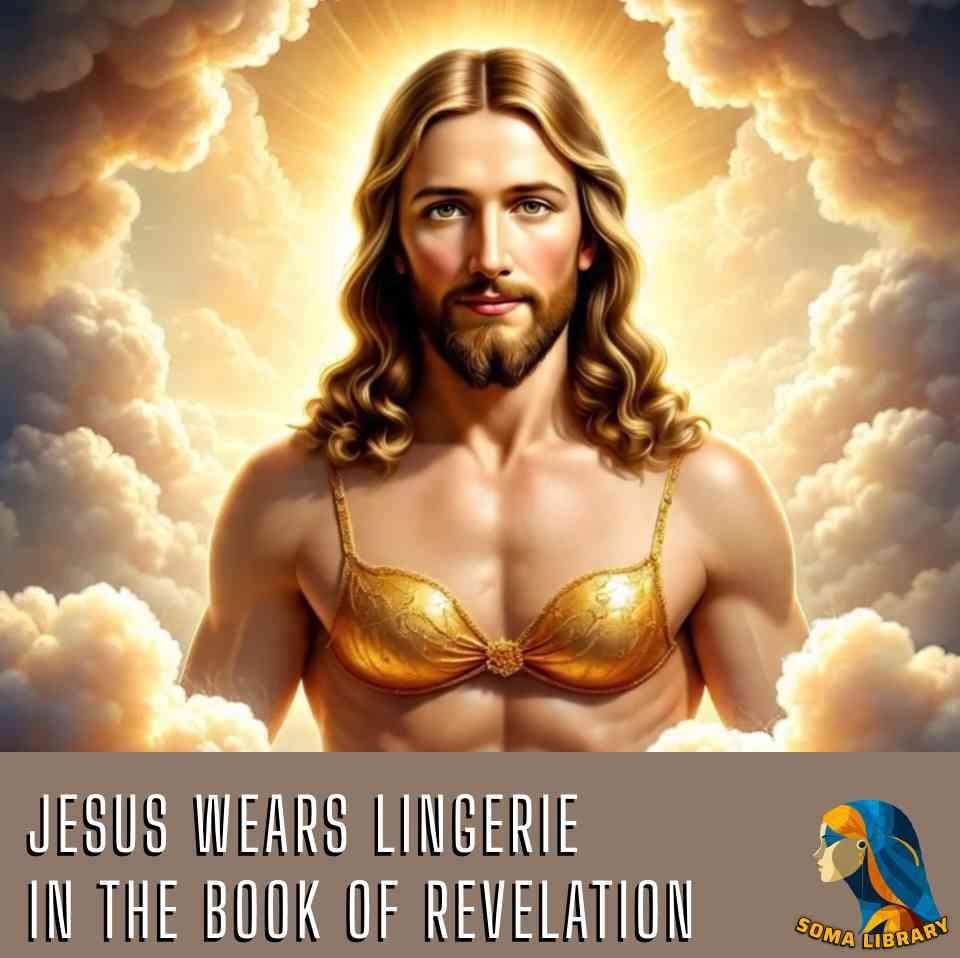Jesus has Breasts in Revelation 1:13

in Revelation 1:13
Luke 11:27 N-NMP
GRK: σε καὶ μαστοὶ οὓς ἐθήλασας
NAS: that bore You and the breasts at which
KJV: and the paps which
INT: you and [the] breasts at which you nursed
Luke 23:29 N-NMP
GRK: ἐγέννησαν καὶ μαστοὶ οἳ οὐκ
NAS: bore, and the breasts that never
KJV: bare, and the paps which never
INT: did bear and breasts which never
Revelation 1:13 N-DMP
GRK: πρὸς τοῖς μαστοῖς ζώνην χρυσᾶν
NAS: across His chest with a golden
KJV: about the paps with a golden
INT: at the breasts a belt golden
Strong's Greek 3149
3 Occurrences
- μαστοί — 2 Occ.
- μαστοῖς — 1 Occ.
mastos: Breast
Original Word: μαστός
Part of Speech: Noun, Masculine Transliteration: mastos
Pronunciation: Mas-TOS
Phonetic Spelling: (mas-tos')
KJV: pap
NASB: breasts, chest
Word Origin: [from the base of G3145 (μaσσáoμaι - gnawed)]
- a (properly, female) breast (as if kneaded up)
pap.
From the base of massaomai; a (properly, female) breast (as if kneaded up) -- pap.
see GREEK massaomai
ἑπτὰ λυχνίας χρυσᾶς, 13 καὶ ἐν μέσῳ τῶν λυχνιῶν, ὅμοιον υἱὸν ἀνθρώπου
ἑπτὰ (seven) λυχνίας (lampstands) χρυσᾶς (golden), καὶ (and) ἐν (in) μέσῳ (the midst) τῶν (of the) λυχνιῶν (lampstands), ὅμοιον (like) υἱὸν (a son) ἀνθρώπου (of man),
ἐνδεδυμένον ποδήρη, καὶ περιεζωσμένον πρὸς τοῖς μαστοῖς ζώνην χρυσᾶν 14
ἐνδεδυμένον (having been clothed) ποδήρη (in a robe reaching to the feet), καὶ (and) περιεζωσμένον (having been girded) πρὸς (at) τοῖς (the) μαστοῖς (female breasts) ζώνην (a sash) χρυσᾶν (golden).
I.one of the breasts, δεξιτερὸν παρὰ μαζόν Il.; βάλε στέρνονὑπὲρ μαζοῖο struck his chest above the breast, id=Il.; βάλεστῆθος παρὰ μαζόν id=Il.2.esp. a woman's breast, μαζὸν ἀνέσχε, of Hecuba mourning over Hector, id=Il.; παῒς δέ οἱ ἦν ἐπὶ μαζῷ Od.; προσέσχεμαστόν, of the mother, Aesch.; of animals, the udder, Eur.II.metaph. a round hill, knoll (French mamelon), Pind., Xen.
See also
- [link]
in Apocalypse
Jesus wore a bra, women's lingerie!
Here is the relevant Septuagint Greek (Swete 1930) passages from the Apocalypse (Ἀποκάλυψις Ἰωάννου) where Jesus is depicted in visionary dress and where he identifies himself as the “Morning Star.”
There's evidence in the New Testament that Jesus claims to be the morning star.
The Golden Girdle (Apoc. 1:12–13)
καὶ ἐπέστρεψα βλέπειν τὴν φωνὴν ἥτις ἐλάλει μετ᾽ ἐμοῦ· καὶ ἐπιστρέψας εἶδον ἑπτὰ λυχνίας χρυσᾶς,
καὶ ἐν μέσῳ τῶν λυχνιῶν ὅμοιον υἱὸν ἀνθρώπου, ἐνδεδυμένον ποδήρη, καὶ περιεζωσμένον πρὸς τοῖς μαστοῖς ζώνην χρυσᾶν.
Translation (literal):
“And I turned to see the voice which spoke with me, and having turned I saw seven golden lampstands,
and in the midst of the lampstands one like a son of man, clothed with a robe reaching to the feet, and girded about the breasts with a golden girdle.”
Here Jesus is portrayed in temple vesture: the long robe (ποδήρης) and the golden girdle (ζώνη χρυσᾶ) placed high “about the breasts,” which in classical dress registers as feminine placement (women girded above the waist, men at the waist). This is the source of the “lingerie” imagery.
The Morning Star (Apoc. 22:16)
Translation (literal):
“I, Jesus, sent my angel to bear witness to you of these things for the churches. I am the root and the offspring of David, the bright morning star.”
Here Jesus explicitly self-identifies with the ancient symbol ὁ ἀστὴρ ὁ λαμπρὸς ὁ πρωϊνός — the “bright morning star,” which in Greek myth and cultus is the planet Phōsphoros (Lucifer), bringer of dawn.
Girdle Imagery Repeated (Apoc. 15:6)
Translation (literal):
“And the seven angels who had the seven plagues came out of the temple, clothed in pure bright linen, and girded about the breasts with golden girdles.”
This repeats the motif: shining linen vesture and golden girdles about the chest — a feminized and eroticized priestly garb in the visionary scene.
Summary of Apocalypse Imagery
- Apoc. 1:13: Jesus wears the ποδήρης (ankle-length robe) and a girdle at the breasts (women’s style).
- Apoc. 22:16: He declares himself ὁ ἀστὴρ ὁ λαμπρὸς ὁ πρωϊνός — “the bright morning star,” the classical Lucifer.
- Apoc. 15:6: Angels also wear linen with golden girdles at the chest, echoing his attire.
This is the exact textual ground for the “Jesus in lingerie / golden girdle” reading: he is dressed in priestly-yet-feminized garments, and he names himself as the morning star, linking to Venus/Phōsphoros and Saturnian mystery language